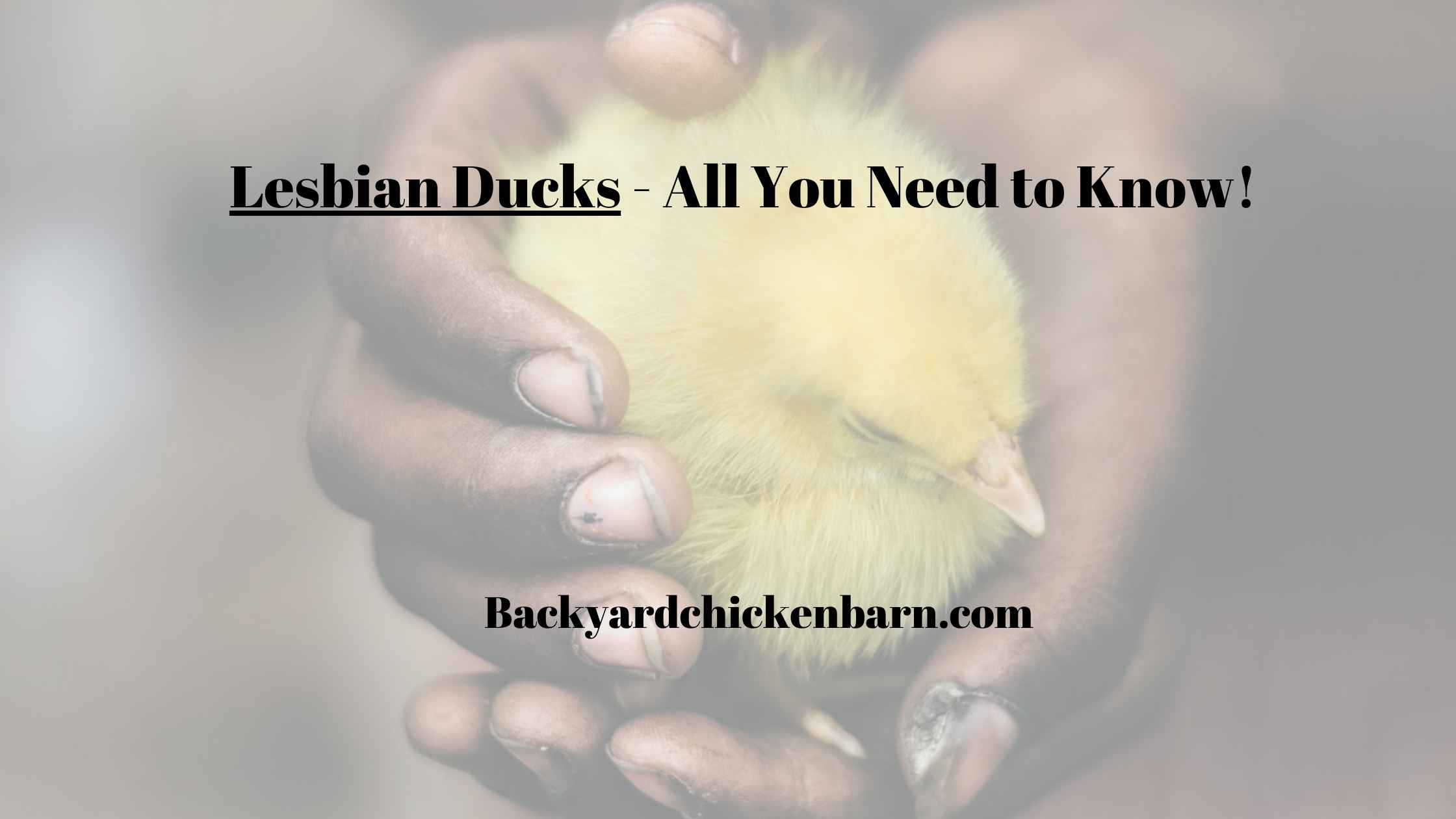Lesbian Ducks: Unpacking Same-Sex Behavior in Birds
The animal kingdom is fascinating and diverse, often mirroring the complexities we see in human relationships and behaviors.
Among these, same-sex behavior has been observed in many species, from mammals like bonobos and dolphins to avian species like ducks.
Let’s delve into the subject of same-sex behavior, often dubbed as ‘lesbian’ behavior, in female ducks.
Observations in Nature
Homosexual behavior in birds is not uncommon. Researchers have documented various avian species displaying same-sex courtship, pairing, mounting, and even parenting.
Female ducks, in particular, have been observed forming close bonds and engaging in mating behaviors with other females.
Reasons Behind the Behavior
The reasons behind homosexual behavior in animals, including ducks, are still being researched. Several theories and observations exist:
- Social Bonding: Birds often form pairs or small groups to help protect territory or share in parenting duties. This bonding can sometimes be seen between members of the same sex.
- Practice: Younger animals might engage in same-sex behavior as a form of practice for future mating.
- Limited Mates: In environments where one gender is significantly outnumbered, same-sex behaviors might increase simply due to the limited availability of opposite-sex partners.
- Reproductive Advantages: Some studies suggest that females in same-sex pairs might have more offspring over their lifetimes. This might be due to multiple factors like reduced harassment from males or increased help in parenting from the partner.
Is it Really “Lesbian” Behavior?
The term “lesbian” is a human construct and may not aptly describe animal behaviors. When we speak of lesbian ducks or gay animals, we’re anthropomorphizing or attributing human characteristics, emotions, or intentions to non-human entities.
It’s essential to approach the topic with an understanding that animals have different motivations and social structures than humans.
Not Just Ducks
While ducks are one of the species where same-sex behavior has been observed, they are by no means alone.
Swans, vultures, albatrosses, and many other birds have documented instances of same-sex pair bonds.
ALSO SEE: Corid Dosage for Chickens

Conclusion
The study of same-sex behavior in animals, including ducks, is a testament to the vast diversity of the natural world. Observations and studies into this behavior help us understand evolutionary patterns, social dynamics, and the multifaceted nature of animal relationships.
FAQs on Same-Sex Behavior in Birds, Focusing on Ducks
- What is same-sex behavior in birds?
- It refers to behaviors such as courtship, mating, and pair-bonding between birds of the same sex.
- Is homosexual behavior common in the animal kingdom?
- Yes, it has been documented in over 1,500 species, including various birds, mammals, and insects.
- Why do female ducks engage in same-sex behavior?
- Reasons can include social bonding, practice, limited availability of opposite-sex partners, and potential reproductive advantages.
- Do only female ducks show this behavior?
- No, both male and female ducks can exhibit same-sex behaviors.
- Is this behavior exclusive to ducks?
- No, same-sex behavior has been observed in numerous bird species, including swans, vultures, and albatrosses.
- Does this mean the ducks are “gay” or “lesbian”?
- Terms like “gay” or “lesbian” are human constructs. While ducks can exhibit same-sex behaviors, it’s anthropomorphic to label them in human terms.
- Do ducks in same-sex pairings reproduce?
- While they cannot reproduce with each other, some female pairs have been observed to mate with males briefly to lay eggs and then return to their same-sex partner for parenting.
- Is this behavior genetic?
- The exact causes are still under research, but it’s likely a combination of genetic, environmental, and social factors.
- Do ducks form lifelong pair bonds?
- Some species of ducks do form long-term bonds, but not all are lifelong.
- Are same-sex pairings as successful in raising offspring?
- Studies suggest that in some cases, female same-sex pairs might have more offspring over their lifetimes due to factors like reduced harassment or shared parenting duties.
- How do researchers study same-sex behavior in birds?
- Through long-term observation, tagging, and monitoring of bird populations in the wild and in controlled environments.
- Do other animals in the same habitat react differently to same-sex bird pairs?
- There’s no conclusive evidence suggesting significant differential treatment by other animals.
- Is same-sex behavior more prevalent in captivity?
- Some studies suggest increased same-sex behaviors in captive environments due to limited mate choices, but it is also observed in the wild.
- Does human intervention or pollution affect this behavior?
- While some pollutants can affect reproductive behaviors in animals, attributing same-sex behavior solely to such factors is simplistic and not supported by comprehensive data.
- How do same-sex bird pairs establish territories?
- Similarly to opposite-sex pairs, using vocalizations, displays, and other behaviors.
- Do ducks have a mating season?
- Yes, most ducks have a specific breeding season, although the timing can vary based on species and location.
- Is there a difference between pair-bonding and mating?
- Yes, pair-bonding refers to the social connection and partnership between two birds, while mating is the act of reproduction.
- Are there specific duck species more prone to same-sex behavior?
- Same-sex behaviors have been observed across various duck species, but comprehensive comparisons between species are limited.
- Do male same-sex duck pairs exhibit different behaviors than female pairs?
- Behaviors can vary, but both male and female same-sex pairs can exhibit courtship, bonding, and parenting behaviors.
- How do birds choose their partners?
- Partner selection can be based on a combination of factors including vocalizations, physical displays, territory quality, and more.
- Can a duck switch between same-sex and opposite-sex pairings in its lifetime?
- Yes, some ducks form pair bonds with same-sex partners in one season and opposite-sex partners in another.
- Are there evolutionary advantages to same-sex behavior in ducks?
- Some theories suggest potential reproductive advantages for female same-sex pairs, but this area requires further research.
- How do young ducks learn mating behaviors?
- Through a combination of instinct and observation of older ducks.
- Are same-sex behaviors in ducks influenced by population density?
- It’s possible, as areas with skewed sex ratios might see increased same-sex behaviors due to limited mate availability.
- Do same-sex bird pairs defend their nests?
- Yes, like opposite-sex pairs, they will defend their territory and nest against intruders.
- How do ducks communicate with their partners?
- Through vocalizations, body movements, and other behaviors.
- Can same-sex behavior in ducks be seen worldwide?
- Yes, it has been documented in various regions and across different duck species.
- Is same-sex behavior in animals considered “unnatural”?
- No, it is a naturally occurring behavior observed in various species across the animal kingdom.
- Do ducks mate for life?
- Some species of ducks form long-term bonds, but not all are lifelong.
- Is same-sex behavior more common in certain age groups of ducks?
- Younger ducks may sometimes engage in same-sex behavior as practice, but it’s observed across age groups.
- Does the environment, like temperature or food availability, influence duck mating behaviors?
- Environmental factors can influence reproductive behaviors and timing but attributing same-sex behaviors solely to these factors is not conclusive.
- Do same-sex duck pairs adopt orphaned ducklings?
- There have been observations of same-sex pairs, both male and female, taking care of ducklings, whether adopted or from one partner’s previous mating with an opposite-sex duck.
- How do other ducks in a flock react to same-sex pairs?
- Reactions can vary, but many same-sex pairs integrate seamlessly into the flock without significant issues.
- Are there rituals or dances associated with duck courtship?
- Yes, ducks often have specific displays, vocalizations, and movements associated with courtship.
- Is same-sex behavior seasonal or year-round?
- While ducks have specific breeding seasons, pair bonds, whether same-sex or opposite-sex, can be maintained outside the breeding season.
- How does same-sex behavior in ducks compare to that in other birds?
- The specifics can vary by species, but same-sex behaviors, in general, are observed across numerous bird species.
- Are there cultural or regional differences in human interpretations of same-sex behavior in ducks?
- Yes, human interpretations of animal behavior can be influenced by cultural, societal, and personal beliefs.
- How do ducks raise their young?
- Typically, the mother duck incubates the eggs and cares for the ducklings once hatched, with some species seeing contributions from the father or partner.
- Do same-sex pairs have a specific role division when raising ducklings?
- Role division can vary by individual pairs and species, with some sharing responsibilities equally.
- Do male ducks exhibit paternal instincts?
- In some species, male ducks play a role in protecting the nest and raising the ducklings, but this can vary.


